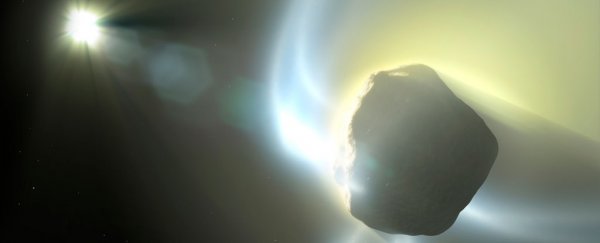There are few bigger questions than how life first got started on Earth, but trying to put in the detective work almost 4 billion years after the event is understandably hard going for scientists. Now it looks as though we might have found another clue.
New research focuses specifically on peptides, smaller versions of proteins, and one of the basic building blocks required for life to exist. They control all kinds of processes in the body, and usually, water needs to be around for these peptides to form.
Amino acids are the organic compounds that make up peptides. The new study demonstrates how a chemical precursor called amino ketene – which can form the amino acid glycine – can be created in cosmic conditions and without any water present. In fact, the water stage can be skipped.
"Instead of taking the chemical detour in which amino acids are formed, we wanted to find out whether amino ketene molecules could not be formed instead and combine directly to form peptides," says astrophysicist Serge Krasnokutski, from the University of Jena in Germany.
"And we did this under the conditions that prevail in cosmic molecular clouds, that is to say on dust particles in a vacuum, where the corresponding chemicals are present in abundance: carbon, ammonia, and carbon monoxide."
The team used an ultra-high vacuum chamber to mimic space and substrates to mimic dust particles to show a reaction pathway that works at about one quadrillionth of normal air pressure and at a temperature of minus 263 degrees Celsius (minus 441 degrees Fahrenheit).
Amino ketene was also detected in the experiments, and the highly reactive nature of amino ketene molecules was probably key to the reaction happening at all, the researchers say – otherwise, it would simply have been too cold to work.
In other words, the conditions inside cosmic dust clouds could potentially enable peptides to form, which might be how they made their way to Earth. It's another avenue for scientists to investigate, showing that the right chemical mix on our own planet wasn't necessarily needed to bring life into being.
"Investigations showed that under these conditions, the peptide polyglycine was formed from the simple chemicals," says Krasnokutski.
"These are therefore chains of the very simple amino acid glycine, and we observed different lengths. The longest specimens consisted of eleven units of the amino acid."
Even with the high reactivity of the amino ketene molecules, the results were still surprising to the scientists – they suspect that quantum mechanics may be playing a part in overcoming the energy barriers to the chemical reaction.
If that's the case at these super-small scales, hydrogen atoms could be tunneling through the energy barrier rather than surmounting it. This is one of the areas that might be investigated through future research.
Scientists are already busy trying to figure out which ingredients for life may have arrived from outer space and which were mixed right here on Earth. The new study offers some more clues about the origin of life – both here and potentially on other planets.
"The delivery of biopolymers formed by this chemistry to rocky planets in the habitable zone might be an important element in the origins of life," conclude the researchers.
The research has been published in Nature Astronomy.
